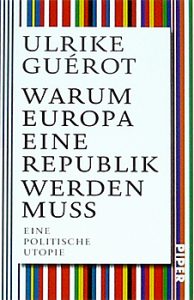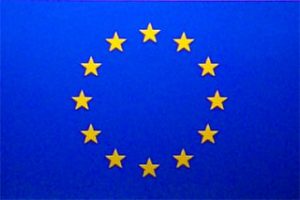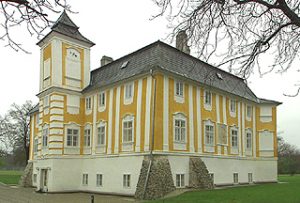
Ulrike Guérot is a political scientist and journalist. She began her studies in Paris and also studied at the University of Bonn, graduating in 1995 with a paper entitled “On The European Program of French Socialism”. Both during and after her studies she worked in various capacities at organisations specialising in German and European politics. In addition she was assistant professor at the John Hopkins University in Washington and taught in Singapore. From 2004-2007 she was Foreign and Senior Transatlantic Fellow at the German Marshall Fund. From 2007-2013 she was German Senior Associate at the Open Society Initiative for Europe. In 2013 and 2014 she taught at the Viadrina University of Europe in Frankfurt and at the Bucerius Law School in Hamburg. In 2014 she founded the European Democracy Lab, a think-tank based in Berlin at the European School of Governance. From 2016-2021 she was professor at the Danube University of Further Education in Krems where she was head of the Department for European Politics and Democracy Research. In 2018, Guérot was one of the founding members of the Balcony Project, in which intellectuals and cultural institutions called for the founding of a European Republic. From 2021-2023 she was Professor for European Politics at the University of Bonn and co-headed the University’s Ernst Robert Curtius Centre. The author and co-author of numerous books, Ulrike Guérot works both as a political scientist and as a brain-stormer, who bounces ideas about and questions commonly held assumptions about how things should be done. In what follows, her questions concerning the role and function of the European Union are introduced.

In “The Founding of a European Republic”, a manifest written in 2013, Ulrike Guérot and the Austria author and political essay-writer, Robert Menasse, argued for the founding of a post-national European republic of regions. Far from being a “United States of Europe”, with an implicitly aggressive foreign policy that rested on an omnipresent willingness to use military options, they envisage a transnational Europe of fifty to sixty regions, in which the idea of nationhood is dissolved and replaced by a European ideal. This they see as being achieved through a unified system of unemployment benefit and a generously funded system of education and transnational media, with the aim being to establish a new form of post-national democracy. The idea of a trans-national Europe presupposes direct parliamentary representation and to some degree a common system of taxation. With respect to representation, Guérot agrees with Brexiteers that the European Union in its present form is undemocratic and in need of extensive reform. The departure point of reform, she and Menasse argue, must be the actual needs of people and not fictions conjured up by national politicians. Pragmatists have they say, brought the European Union to its current crisis, as instead of leading it towards its originally intended ideals (which were to have resulted in the dissolution of nation states) they have initiated an opposing process. In reality the authors argue, the idealists “are the true realists, who are to be thanked for inspiring ideas and for the political realisation of the basis of a modern Europe with rational but with, for the time, utopian-sounding implications. These arose out of the experience of National Socialism and the pre-war European politics of day to day survival, that later left the continent in dust and ashes.” Historically the nation state has, the authors point out, a bad track record. In 2016, in her book, Why Europe must become a Republic! A political Utopia, Guértot described the ideas formulated in the manifest with Menasse in more detail. A year later the German paper, Suddeutsche Zeitung, named her book, The New Civil War. Open Europe and her Enemies, as book of the month.

In 2017, Guérot initiated a project in Krems in which the non- or trans-national republic Neutral-Moresnet was taken as a theme. After Napoleon’s defeat at Waterloo, Moresnet was claimed by both the then Netherlands (which included Belgium) and Prussia and as no agreement could be reached, it was decided to divide the contended area into three with the two countries each receiving a piece, whilst the middle segment was declared neutral and to be run by both countries in cooperation.

This agreement remained in place until 1919, by which time the area was being run by Belgium and Germany whilst by 1914 the initial population of 256 had grown to 4668. In 1881, the state was proclaimed an Esperanto state by then Vice Lord Mayor and from 1907 on, Esperanto enthusiasts called Neutral-Moresnet, Amikejo, which means “Place of Friends”. Nevertheless, the first officially acknowledged pan-European movement was the Pan-European Union, which was founded in 1922 by Richard Nikolaus Coudenhove-Kalergi (1894-1972), as a reaction to the horrors of the First World War. An Austrian count, writer and philosopher, Coudenhove-Kalergi saw national states as having arrived at a dead end, with some form of unification being essential if they and the European continent were not be overtaken by the United States and the then Soviet Union. The flag chosen was a red cross, set in a yellow circle against a blue background.

The yellow sun represented The Enlightenment, the cross stood for humanity and the flag expressed the movement’s conviction that a united Europe should be based on Christian values. Under National Socialism the movement was banned, with Otto von Habsburg (1912-2011) being placed on a list of wanted men and Coudenhove-Kalergi being denounced as a freemason while other members were deported to concentration camps. Both before and after the war, the movement included top-ranking political figures. In 1947, Coudenhove-Kalergi founded the European Parliamentary Union which paved the way for the setting up of a European Parliament. Perceptively, in an updated formulation of the organisation’s aims made in 1966, not only was atheism condemned but also the nihlism that attends modernism and irresponsible, senseless consumerism (for a non-religious analysis of the anthropological mechanisms that are at work here, the reader is referred to the article on Philipp Blom). Following the founding of the European Union, the sun on the movement’s flag was enclosed by the twelve stars.

After Coudenhove-Kalergi’s death in 1972, presidency of the Pan-European Union was assigned to Otto Habsburg who after the fall of the Iron Curtain successfully campaigned to ensure that Eastern Europe would not be abandoned again, with the movement backing the applications of numerous Eastern European countries in their applications for membership of the European Union.
Although one can be dismissive of the Pan-European Union due to its aristocratic background, conservative attitudes and in today’s secular climate, arguably disproportionately heavy emphasis on Christianity, the social and environmental damage caused over the last forty years by the godless, egoistically orientated consumer societies of the West is hardly something that anyone can be proud of and force one to concede that somewhere, something is missing. Going back in time, beyond Amikejo, the invention of Esperanto and the nation states of the nineteenth century, one sees that for centuries, Europe was a conglomeration of regional entities held together by agreements of allegiance to an overreaching construction that was for the good of all. This was the Holy Roman Empire and in seeking a European solution to the malaise of the present it is instructive to return to the roots of this idea.

The imperial throne in the cathedral in Aachen where the Holy Roman Emperor was crowned
Whilst candidature for the post of Holy Roman Emperor was a matter of birth, candidates proposed only became emperors once ratified through election by the Electors who headed the states and principalities of which the Empire was composed. At his investment in Aachen, the Emperor then swore an oath on the Imperial Evangeliary.

This he did by placing his right hand on the first page of the Gospel of Saint John which begins with the sentence, “In the beginning was the Word and the Word was with God and the Word was God”.

The Imperial Evangeliary of the Holy Roman Empire open at the Book of John. Now housed in the Treasury of the Hofburg in Vienna
In swearing on these words, the Emperor was invoking the Word of God as the basis for his rulership, legitimising himself in this way as God’s representative on Earth. Underling this, the words of the Evangeliary are written in gold, on pages that have been dyed purple – the colour exclusively reserved for emperors. The book was made for Charlemagne (742-814) and in the work, the Evangelists are shown as Antique philosophers, dressed in togas and seated amid landscapes. Thus, while they transcribe the word of God, they recall the world of Rome and the early Church. In legend, Charlemagne was buried in a seated position, with the precious volume resting on his knee and when his grave was found by Otto III, the Evangeliary immediately became a part of the imperial regalia.

The insignia of the Holy Roman Emperor. Now to be seen at the Treasury in Vienna
When one contrasts this deep piety with the strictly secular nature of European Union ceremonies today, a seemingly all-engulfing void of emptiness opens up and one cannot help being reminded that this is secular age and that all too often, the only thing that counts is money attended by an attitude of slick, know-all cynacism. This is the nihlism condemned by the Pan-European Union in their 1966 statement. Although since 1985 the European Union has a extract from Beethoven’s Ode to Joy as an anthem, it is repeatedly played in circumstances where one cannot help experiencing the rendition as an empty gesture that for all Beethoven’s genius, has but little weight. Yet if one looks it is possible to find something that fills the void. In Krems, Holy Roman Emperor Otto III is important, as after defeating the Magyars at the Battle of Lechfield near Augsburg, he initiated the re-population and colonisation of the Wachau and it is in the decree pertaining to this that Krems is mentioned for the first time. Meanwhile it was in Schloß Wasserhof, near Krems, that Beethoven wrote his last work.

This was String Quartett No. 135 and the score bears the remark: “The difficultly made decision: Must it be? It must be! It must be!”

Behind this assertion interpretations often assume a resigned form pessimism, yet following the musicologist Sebastian Permoser and seeing the remark as playfully alluding to the clearly ironic canon It must be, yes, yes, out with the loot! (Wo0 196), makes it possible to see it as a playful acceptance of the up and downs of life. For Permoser’s late collegue, Martin Geck:
Beethoven’s late love of his own self as a tortured creature and via this, of the whole of humanity, does not admit being compressed through art and being harmonised, for it must be endured in its disparity and yet nevertheless it manifests itself in work. This is neither complete nor incomplete, neither homogeneous nor fractured, neither an individual psycho-gram, nor an objectified structure, it radiates neither weakness nor sovereignty; but rather indicates an idea of the complex truth of a never-resting artist’s existence with all its experiences of happiness and dissatisfaction. By repeatedly chasing after this idea, we too seek out our own truth.
The relevance of this to Beethoven’s Ode to Joy being used as the hymn of the European Union is that if we wish the extract to be endowed with something equivalent in weight to the piety summed up and expressed in the regalia of the Holy Roman Empire, then we as individuals must also be prepared to contribute something and be willing to imbue that which we hear with a significance and solemnity that reflects something of the European experience, the European way of life and the European mentality. Whilst different from the definition of art arrived at by Friedrich Schiller (see the article on Hanno Rauterberg), there are similarities in that which is contemplated, absorbed and consumed is something ever-shifting and which whilst being definite, is also evasive. Returning to Ulrike Guérot’s vision of a Europe of regions that is united through education, knowledge and culture, both formulations (Geck’s characterisation of the human content of Beethoven’s music and Shiller’s definition of art) show that the only genuine and non-superficial option is when the innate complexity of education, knowledge and culture is admitted. This turns their pursuit into an ideal and a life-long occupation that only bears fruit when the self is prepared to bow to the weight of something that lies over and above it. Put in plainer terms, Guérot’s Europe can only come to be when knowledge and the experiencing art and wisdom are sought as things in themselves and are not used means to the making of money or as exercises in upstaging. Like the ideals of the idealists praised by Guérot and Menasse, we must take the culture and traditions of our continent seriously and treat them as things whose preservation is to be striven for if we are to preserve our identity and work successfully towards a better Europe and a better world.

Es muß sein! Es muß sein!

